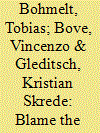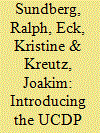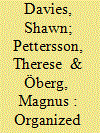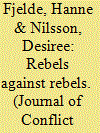|
|
|
Sort Order |
|
|
|
Items / Page
|
|
|
|
|
|
|
| Srl | Item |
| 1 |
ID:
164556


|
|
|
|
|
| Summary/Abstract |
Existing research argues that refugee inflows may increase the risk of domestic conflict, particularly civil war that, by definition, involves the state as an actor. However, many of the postulated mechanisms linking refugees to a higher risk of such conflict pertain to tensions with locals, which do not necessarily involve any grievances against government authorities. We contend that it is more likely to identify an association between refugees and non-state actor violence, that is, armed violence between organized non-state groups, neither of which pertains to the state. We also claim that the extent to which refugees are associated with a higher likelihood of non-state conflict depends on the capacity of governments to manage and mitigate risks. We report evidence that refugee populations can be linked to an increased risk of non-state conflict, as well as for a mitigating effect of state capacity on the risk of non-state conflicts in the presence of refugees. We do not find a clear effect of refugee populations on civil war, suggesting that the link depends on existing conflict cleavages relevant to mobilizing refugees or locals. Our research helps to shed light on the relevant security consequences of managing refugee populations. Despite the common arguments portraying refugees as security risks in developed countries, the risk of non-state conflict applies primarily to weak states that have been forced to shoulder a disproportionate burden in hosting refugees.
|
|
|
|
|
|
|
|
|
|
|
|
|
|
|
|
| 2 |
ID:
112781


|
|
|
|
|
| Publication |
2012.
|
| Summary/Abstract |
This article extends the Uppsala Conflict Data Program (UCDP) by presenting new global data on non-state conflict, or armed conflict between two groups, neither of which is the state. The dataset includes conflicts between rebel groups and other organized militias, and thus serves as a complement to existing datasets on armed conflict which have either ignored this kind of violence or aggregated it into civil war. The dataset also includes cases of fighting between supporters of different political parties as well as cases of communal conflict, that is, conflict between two social groups, usually identified along ethnic or religious lines. This thus extends UCDP's conflict data collection to facilitate the study of topics like rebel fractionalization, paramilitary involvement in conflict violence, and communal or ethnic conflict. In the article, we present a background to the data collection and provide descriptive statistics for the period 1989-2008 and then illustrate how the data can be used with the case of Somalia. These data move beyond state-centric conceptions of collective violence to facilitate research into the causes and consequences of group violence which occurs without state participation.
|
|
|
|
|
|
|
|
|
|
|
|
|
|
|
|
| 3 |
ID:
186868


|
|
|
|
|
| Summary/Abstract |
This article reports on trends in organized violence, building on new data by the Uppsala Conflict Data Program (UCDP). The falling trend in fatalities stemming from organized violence in the world, observed between 2014 and 2019, was decisively reversed in 2021 as fatalities increased significantly. UCDP registered more than 119,100 deaths in organized violence in 2021, a 46% increase from the previous year. The increase was largely driven by escalating conflicts in Afghanistan, Ethiopia, and Yemen. Fatalities increased in all three categories of organized violence, despite a decrease in the number of active state-based conflicts, as well as the number of actors carrying out one-sided violence against civilians. UCDP recorded 54 state-based conflicts in 2021, a decrease by two compared to the previous year. Five of the conflicts were active at the intensity of war, the lowest number of wars since 2010. Violence in 2021 was thus concentrated to fewer but bloodier conflicts. Unmanned aerial vehicles (UAVs), commonly known as drones, have become increasingly important features of modern conflicts, and the trend in their usage is discussed in the special feature section. UAV usage has since 2019 dispersed among a significant larger number of actors, even as the downscaling in the involvement of the United States in the war on terror has led to a decrease in drone-related fatalities.
|
|
|
|
|
|
|
|
|
|
|
|
|
|
|
|
| 4 |
ID:
113948


|
|
|
|
|
| Publication |
2012.
|
| Summary/Abstract |
Rebel groups that confront the government frequently become engaged in fierce and violent struggles with other groups. Why does a rebel group who is already fighting with the government become engaged in yet another struggle, thereby sacrificing scarce resources in the fight against other rebel groups? This article addresses this puzzle by providing the first global study on the determinants of interrebel violence. The authors argue that this violence should be understood as a means to secure material resources and political leverage that can help the group prevail in the conflict with the government. The quantitative analysis builds on new data on armed conflict between nonstate actors, 1989-2007. The results show that interrebel conflict is more likely when the rebel group fights in an area with drug cultivation, when the group is in control of territory beyond government reach, when the group is either militarily strong or weak in relation to other rebels, and where state authority is weak.
|
|
|
|
|
|
|
|
|
|
|
|
|
|
|
|
|
|
|
|
|